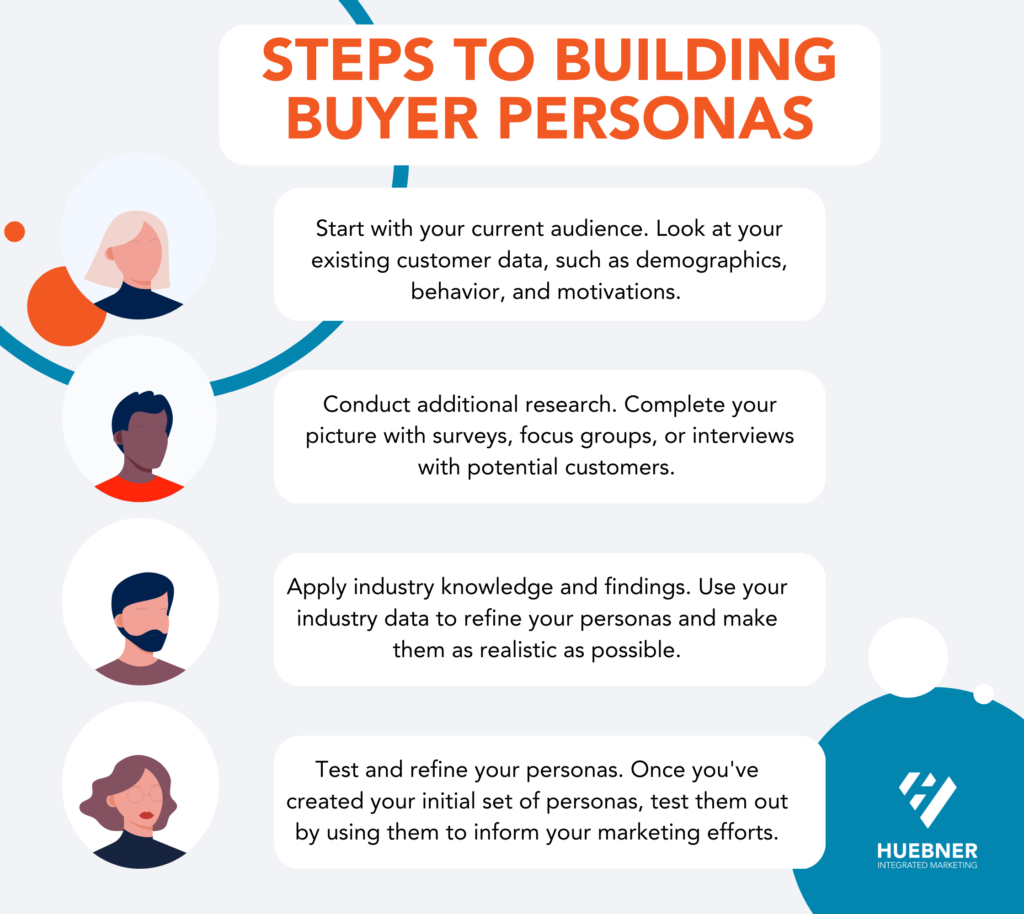Do you know who is buying your product? Have you dug deeper than the standard M/F 35-60? Breaking through the surface demographic data can help you effectively market and sell your product or service, allowing you to align messaging and messaging channels to the specific needs, interests, and preferences of YOUR ideal customer. In short, accurate buyer personas help you express your product value in a relevant way, and build meaningful relationships with your customers. Sounds like a dream, right? Let’s get started.
What is a Buyer Persona?
A buyer persona is a semi-fictional representation of your ideal customer, based on market research and real data about your existing customers. It’s an important tool that helps you understand your customers better, providing insights into interests, needs, preferences, and online/in-person behaviors.
For B2B companies, the term buyer persona can be further broken into two groups: buyer persona and user persona. While user personas represent the end-user, or people who will actually use your product; buyer personas represent the people making purchasing decisions for their organization. It’s important to create separate personas for these two groups, as their needs and motivations may be different.
How Many Buyer Personas Should You Have?
When it comes to creating buyer personas, it’s important to strike a balance. On the one hand, it’s essential to segment your audience and create specific personas for different types of customers. This will allow you to tailor your marketing efforts to the specific needs and preferences of each group. On the other hand, if you create too many buyer personas, your messaging will become too fractured in efforts to meet every audience demand.
It’s ok if you get started on this effort and find you’ve created too many personas. It happens to the best of us, and really means you’re putting in great effort into understanding your consumer! Combining personas into larger, more manageable groups is possible, and important to keeping your messaging consistent.
To determine the right number of buyer personas for your business, consider your target audience and the size of your market. It’s generally a good idea to start with a few (3-4) broad personas and then drill down into more specific segments as needed.
How to Build Buyer Personas
Building buyer personas requires research and analysis. Steps to follow while building your buyer personas include:
- Start with your current audience. Look at your existing customer data, such as demographics, behavior, and motivations. This will give you a starting point for creating your personas. Check their paths to sale, and levels of engagement throughout your marketing communications to understand what is working and what could use improvement.
- Conduct additional research. To get a more complete picture of your target audience, you may want to conduct surveys, focus groups, or interviews with potential customers. Make sure to ask questions that will help you understand their needs, preferences, and decision-making processes. These can be done by outside parties, via email or social media, and within retail locations, to name a few.
- Apply industry knowledge and findings. Use your knowledge of your industry and the market to refine your personas and make them as realistic as possible. Look at sales data, consumer feedback, and industry trends and reports. Speak with your sales reps for a better understanding of the conversations they have to facilitate sales.
- Test and refine your personas. Once you’ve created your initial set of personas, test them out by using them to inform your marketing efforts. See how well they perform, and make adjustments as needed. Examples of persona testing can include changing your messaging style in emails, ad campaigns directed specifically to personas, social media ads, and partnerships/sponsorships with coordinating brands. Engagement rates will tell you if you’re on the mark.

How to Structure Buyer Personas
When building your buyer personas, it’s helpful to use a consistent structure for each one. You can use a template or chart to help you organize the information you’ve gathered. (We made one to help you get started!) Some common pieces of information to include are:
- Profession: What does the persona do for a living?
- Leisure preferences: How does the persona like to spend their free time?
- Product-related challenges: What problems or challenges does the persona face related to your product or service? Or, what problems does this persona face that your product can alleviate?
- Motivators/goals: What drives the persona and what are their goals, purchase-wise?
- Information-gathering habits: How and where does the persona prefer to get information about products or services like yours?
- Communication preferences: How does the persona prefer to be contacted?
- Determining value: How does the persona determine the value of a product or service? Is it through social validation, reviews, research, etc.?
In addition to the above persona data, it can be helpful to also include purchasing behavior for each buyer persona. This will help you understand the path to purchase, and facilitate the build of your your funnel. Four common types of purchasing behavior to consider are:
- Extended decision-making: This tends to be the result of a high-cost product, often considered an investment. In-depth research is involved, and economic risk is considered, before making the financial decision to purchase
- Limited decision-making: This tends to occur when a limited availability of product is on the market. An example of this would be the existence of only two manufacturers who build specialty suspension systems for overlander vehicles. The consumer tends to make their purchasing decision based on their concept of product value rather than price.
- Habitual buying behavior: This tends to be a result of daily routines, where thought and research are less important than convenience. The purchasing decision is based on the need to continue with routine, and a brand that can support that need will become the consumer’s habitual purchase.
- Variety-seeking buying behavior: This tends to occur when a buyer seeks diversity, wanting to try different products within the available brands. The visibility of difference between competitive products is the key factor here, and what must be highlighted in order to procure the sale.
Applying Marketing Strategy to Buyer Personas
Once you’ve created your buyer personas, you can use them to inform your marketing strategy. By understanding the needs, preferences, and decision-making processes of your personas, you can create targeted marketing campaigns that are more likely to be effective.
Here are some tips for applying your buyer personas to your marketing efforts:
- Meet them where they are: Consider the channels and mediums that your personas are most likely to use, and focus your efforts there. For example, if your personas are active on social media, you may want to invest in social media marketing.
- Craft copy, imagery, and messaging that resonates: Use the information you’ve gathered about your personas to create marketing materials that will speak to them. This may include using language and imagery that resonates with their values and interests.
- Personalize your marketing efforts: This one is key. 90% of U.S. consumers find personalized marketing content somewhat to very appealing (Statista). By segmenting your audience into specific personas, you can create more personalized marketing campaigns. This can be as simple as using the persona’s name in an email subject line or as complex as creating customized landing pages for each persona.
As you can see, buyer personas are an invaluable tool to help you connect with your ideal customers. They inform product marketing, support, and even product development, and can truly fast track your path to conversion. We believe in the value of personas so much, that we’ve created a template for you to use in the build of yours. We know that you will find value in the process and the final product, and we wish you luck applying them to your marketing strategy!

